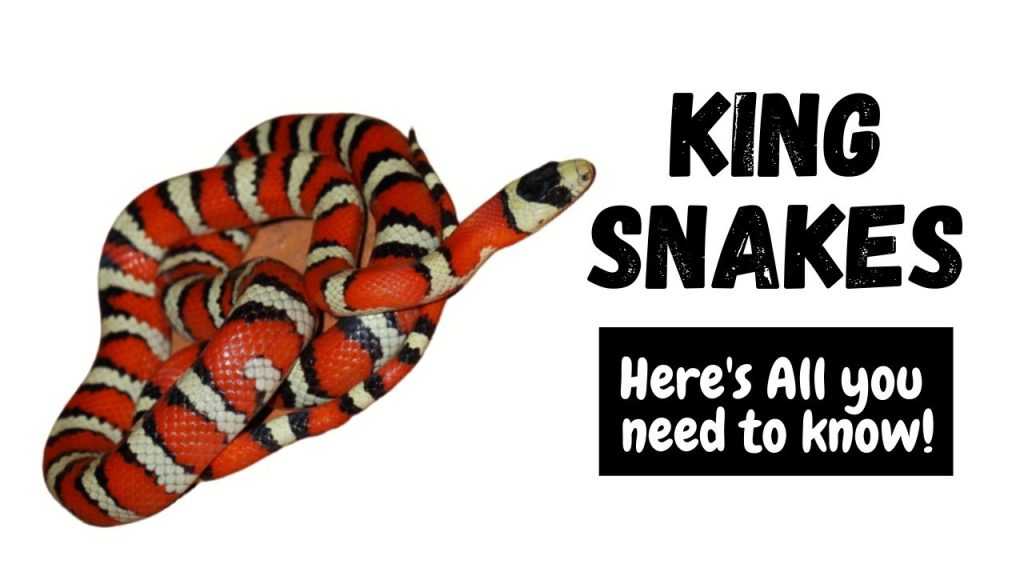The Kingsnakes are the strong and powerful snakes that belong to the family Colubridae (the family of Garter Snakes) and genus Lampropeltis. There are 5 species and more than 47 recognized subspecies of Kingsnakes. The Kingsnakes got their name as their main food item is other snakes. They are famous for their vibrant appearance. They are nonvenomous and constrictor snakes. They grab their prey and coil against its body so tightly that it dies due to cardiac arrest.

Habitat of the Kingsnakes
The Kingsnakes are the inhabitants of Southeastern and Southwestern America, Canada, and northern Mexico. The Kingsnakes enjoy living in rocky areas, forests, fields, grassy lands, and deserts. Generally, the Kingsnakes are terrestrial. They are found living more on the lands, under the rocks, and logs than in water or over the trees. However, some water-loving Kingsnakes are often found near riverbanks.
Physical Characteristics of the Kingsnakes
The following physical features make the Kingsnakes easily identifiable amongst other snake families.
Size
Kingsnakes are the medium-sized snakes ranging from 4 to 6 feet in length.
Skin and patterns
The Kingsnakes have a very distinctive appearance. They have skin with smooth scales, bands, rings, longitudinal stripes, saddle-shaped bands and speckles over the dorsal and the belly, and give a chain-like look to the snake’s body.
Colors
The Kingsnakes appear in vibrant and bright colors like red, grey, lavender, orange, yellow, black, brown, and rust.
Eyes
Like all the nonvenomous snakes, the KIngsnakes also have big eyes with a round pupil.
Head
The Kingsnakes have a spoon-shaped head with a rounded jaw.
Life Span
The life of Kingsnakes living in the wild can be uncertain. Generally, the Kingsnakes live up to 30 years.
Species of The Kingsnakes
The 5 species of Kingsnakes having 45 subspecies are described below with their complete features.
Easterns Kingsnakes
The Eastern Kingsnakes are known with many other names like common Kingsnakes, chain snakes, or chain kings. The scientific name of the Eastern kingsnake is Lampropeltis getula. These snakes are known by these names for having chain-like distinctive markings on their bodies.
The body of this snake has black shiny scales with yellow or white bands. They usually have a black body. These chain-like bands are very thin and narrow in the eastern kingsnakes from mountainous regions and wide in the eastern kingsnakes of coastal areas.
Eastern Kingsnakes are majorly found in the areas ranging from west Florida to the Appalachians and southeastern Alabama, and from north Florida to the southern New Jersey.
Scarlet Kingsnake
Scarlet kingsnakes are the small-sized species of this snake family. Their scientific name is Lampropeltis elapsoides.
These snakes often resemble the venomous coral snakes to keep the predators away. This phenomenon is termed as ‘Batesian mimicry’ where a harmless species mimics a harmful species of the snake family.
There is a difference in the band patterns of both snakes. The scarlet kingsnakes have a red body with black and yellow bands while the coral snakes have red and yellow bands.
Scarlet Kingsnakes are found in central Virginia, Florida, and the west of Mississippi. Their average size is 1 to 2 feet.
California Kingsnakes
California Kingsnakes are small snakes but longer than Scarlet kingsnakes. Their scientific name is Lampropeltis getula californiae.
Their body has black shiny stripes with white markings on them. Some kingsnakes of this species have bands while some have longitudinal stripes running down from head to the tail.
The California Kingsnake is most commonly found everywhere in the Golden State, dry regions of Oregon, Mexico, and Colorado. The average size of the California Kingsnakes is 2.5 to 4 feet.
Black Kingsnake
As the name suggests, Black Kingsnakes are the snakes with a jet black color. Sometimes, their black skin appears with yellow or white spots and bands. The Black Kingsnake has a scientific name as Lampropeltis getula nigra.
Black Kingsnakes are mostly found in northwestern Georgia, southern Ohio, western Virginia, and northeastern Mississippi. The average length of these snakes is 4 to 5 feet.
Speckled Kingsnakes
A speckled kingsnake is a form of black kingsnake with more vibrant scalings and markings. Lampropeltis getula holbrooki is the scientific name of this snake species.
Speckled kingsnake is a colorful snake with speckles on each blackish or brownish scale and is available in various sizes ranging from 3 to 4 feet. With the equal distribution of speckles, it is also known as salt and pepper.
The Speckled kingsnake vibrates its tail when it feels dangered and produces a rattle like the sound if hidden in dry leaves. It is found in Central America, Texans, and Alabama.
Behavior and Habits of the Kingsnakes
Generally, the Kingsnakes are nonvenomous snakes with a docile nature which makes them good pets. However, some species are known to be ‘bitier and snappier’ than other species of this family.
They are usually nocturnal in the hot areas and hunt during the night or early morning, but they also come out for hunting at day time in the cold regions.
During the winter, the Kingsnakes hibernate in the caves, rocks, and logs. When threatened, the Kingsnakes secrete a musk with bad smell and vibrate their tail producing a rattle-like sound. Some Kingsnakes also bite as a defensive reaction but their bite does not contain venom.
Feeding and Hunting of the Kingsnakes
The Kingsnakes are nonvenomous snake species that get their prey by grabbing it in their mouth and then constraining it by tightly coiling against its body. The prey suffocates and dies due to cardiac attack most of the time. Due to suffocation, the lungs also stop working and the prey dies due to lung failure. The whole prey is then swallowed by the kingsnakes.
The Kingsnakes are active hunters. They follow the scent of the prey and then attack it. The Kingsnakes are referred to as having an Ophiophagous diet. This is a greek term referring to the ‘snake eaters’. The favorite meal of Kingsnakes is other snakes. They can eat both the venomous snakes like Pitviper and nonvenomous snakes like Garter snakes. However, they also like to eat turtle eggs, frogs, lizards, rodents, birds, and eggs.
After eating once, a Kingsnake does not come out for hunting for several weeks or months until it completely digests the previous food.
Reproduction of the Kingsnakes
Kingsnakes are oviparous species of snakes and lay eggs. The Kingsnakes of the hot climates mate during early spring while the species of cold regions mate in late spring or early summer and the females often lay eggs more than once in a season.
The males follow the females through their scents. After that, the males fight with each other for mating. The winner is then allowed to mate. The female does not care for the eggs after laying and the eggs hatch on their own.
Final Words
The Kingsnakes have a quite distinctive appearance and they are also the nonvenomous snake species. These two attributes attract many people to keep the kingsnakes as pets. It is not a bad idea if precautionary measures are taken properly.







